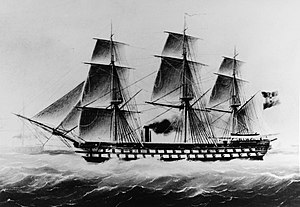
Back SMS Kaiser (1860) Czech Kaiser (skib, 1859) Danish Kaiser (Schiff, 1859) German اساماس کایزر (۱۸۵۸) Persian SMS Kaiser (1858) French SMS Kaiser (1858.) Croatian SMS Kaiser (1858) Italian SMS Kaiser (1858) Portuguese SMS Kaiser (1858) Serbo-Croatian SMS Kaiser (1858) Ukrainian
 SMS Kaiser in her original configuration
| |
| History | |
|---|---|
| Name | SMS Kaiser |
| Namesake | Kaiser |
| Builder | Pola Navy Yard |
| Laid down | 25 March 1855 |
| Launched | 4 October 1858 |
| Commissioned | 1859 |
| Renamed | Bellona, 1902 |
| Fate | Unknown after 1918 |
| General characteristics (as built) | |
| Type | Ship of the line |
| Displacement | 5,194 long tons (5,277 t) |
| Length | 74.02 m (242 ft 10 in) |
| Beam | 16.21 m (53 ft 2 in) |
| Installed power |
|
| Propulsion |
|
| Complement | 900 |
| Armament |
|
| Class overview | |
| Name | (As ironclad) |
| Preceded by | Erzherzog Albrecht |
| Succeeded by | Kaiser Max class |
| General characteristics (1873) | |
| Type | Casemate ship |
| Displacement | 5,720 long tons (5,810 t) |
| Length | 78 m (255 ft) |
| Beam | 699 in (58 ft 3 in) |
| Draft | 290 in (24 ft 2 in) |
| Installed power | 2,786 ihp (2,078 kW) |
| Speed | 11.55 knots (21.39 km/h; 13.29 mph) |
| Range | 1,519 nautical miles (2,813 km; 1,748 mi) at 10 knots (19 km/h; 12 mph) |
| Complement | 471 |
| Armament |
|
| Armor | |
SMS Kaiser was a 92-gun wooden ship of the line of the Austrian Navy, the last vessel of the type, and the only screw-driven example, to be built by the Austrians. She was built by the naval shipyard in Pola; she was laid down in March 1855, was launched in October 1858, and was completed the following year. The ship took part in the Second Schleswig War of 1864, but saw no action during her deployment to the North Sea. Kaiser did see action during the Seven Weeks' War two years later, during which she took part in the Battle of Lissa as the flagship of Anton von Petz, commander of the Austrian 2nd Division. Kaiser engaged several Italian ironclads simultaneously, rammed one—Re di Portogallo—and damaged another—Affondatore—with gunfire. In doing so, she became the only wooden ship of the line to engage an ironclad warship in battle.
In 1869, the Austro-Hungarians decided to rebuild Kaiser into an ironclad casemate ship; the work lasted until 1873, and was delayed significantly by budget shortfalls, which slowed the acquisition of armor plate from British firms. By this time, however, casemate ships were being superseded by turret ships, and as a result, Kaiser spent the years 1875–1902 in reserve. She was nevertheless modernized periodically throughout the 1870s and 1880s in attempts to improve her performance. In 1901–1902, she was renamed Bellona and had her armament and engines removed so she could be used as a barracks ship in Pola, a role she filled through World War I. Italy seized the ship as a war prize after the end of the conflict, but her ultimate fate is unknown.